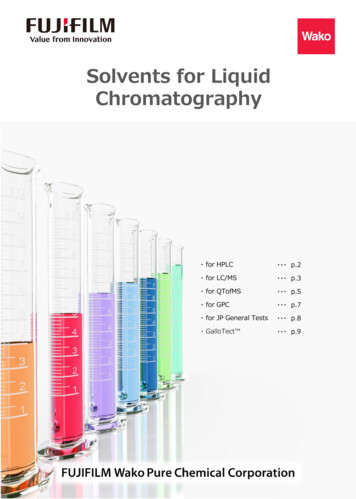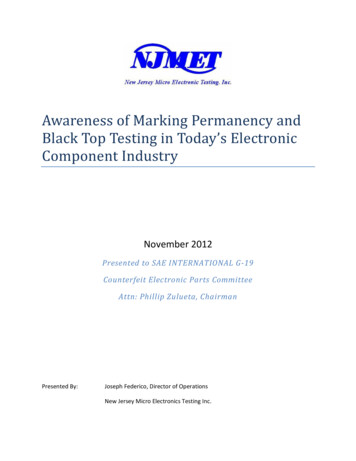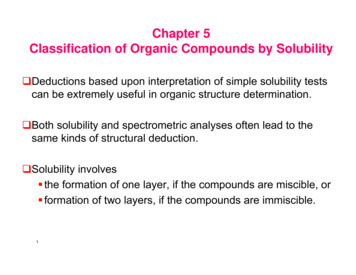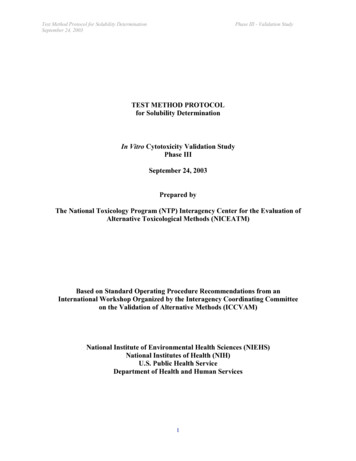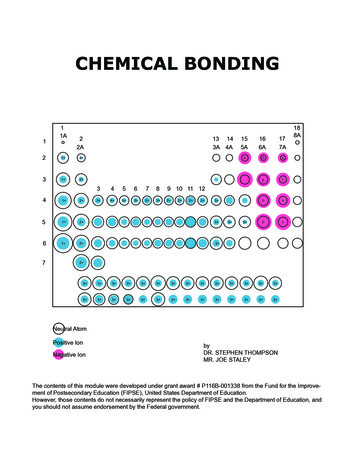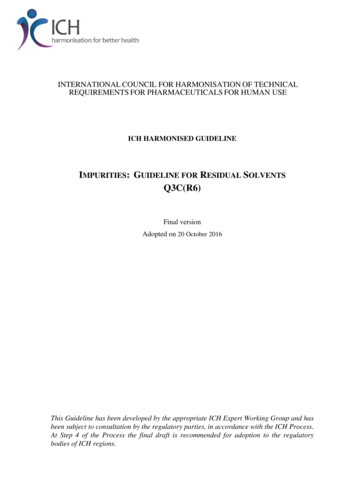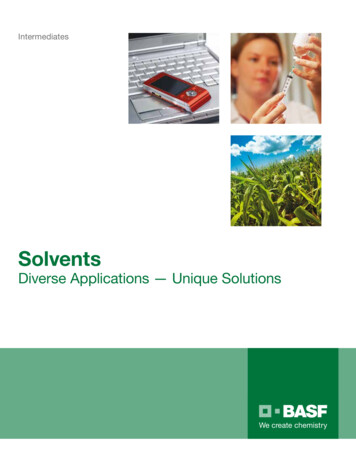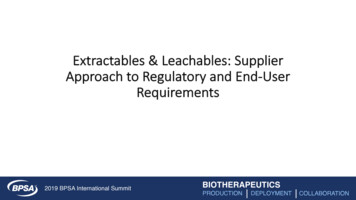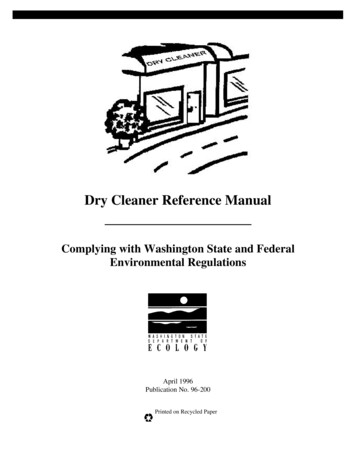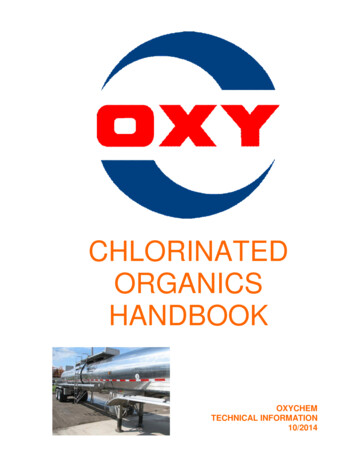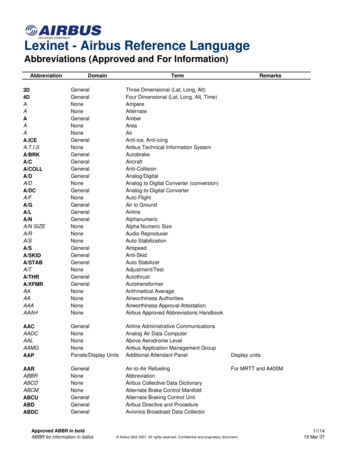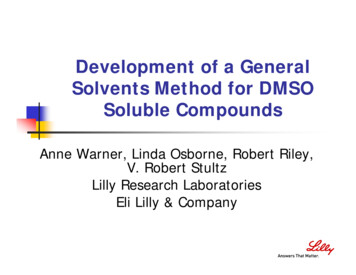
Transcription
Development of a GeneralSolvents Method for DMSOSoluble CompoundsAnne Warner, Linda Osborne, Robert Riley,V. Robert StultzLilly Research LaboratoriesEli Lilly & Company
Outline Goals of Solvent WorkMethod DevelopmentMethod ValidationMethod UseSolvent Control StrategyReference Standards
Goals of General Solvent work Develop chromatographic conditions Resolve all solvents of interest to processdevelopmentMinimize run timeSimilar to USP/PhEur testsObtain accurate results QuantitativeLimit testAssure sensitivity No additional method development whenapplying method to new matrixUse for all steps to monitor/control solvents
Solvent listUSP 467 or*toxicologyTarget, %SolventClassUSP 467 or*toxicologyTarget, %SolventClassAcetone (Actn)*0.453Isopropyl acetate (IPAC)0.53Acetonitrile (ACN)0.0412Methanol (MeOH)*0.252Anisole0.53t-Methyl butyl ether (MTBE)0.53Benzene0.00021Methyl ethyl ketone (MEK)*0.331-Butanol (1-BuOH)*0.053Methyl isobutylketone (MIBK)0.532-Butanol (2-BuOH)0.53Methylene Chloride (MeCl2)0.062Cyclohexane thane0.000511-Pentanol (amyl alcohol)0.53Diethyl ether*0.13n-Propanol (n-PrOH)0.53Dimethylformamide (DMF)*0.0422-Propanol (IPA)0.53DMSO0.53Pyridine0.022Ethanol (EtOH)0.53Sulfolane0.0162Ethyl Acetate (EtOAc)*0.453Tetrahydrofuran (THF)0.0722Ethyl benzene (etbenz)0.03692Toluene0.0892Heptane 0.130220.53o-Xylene0.01952p-Xylene0.03042Isobutyl alcohol (2Me-1-PrOH)
Method Development Temperature program ProEzGC Use same conditions for Direct Injection techniquesHeadspace conditions Evaluate vial conditions Computer based simulation software for gaschromatographyBased on 2 sets of lab runsTemperatureTimeShakeSample solvent/concentration Target 100 mg/mL to assure sensitivityMore compounds soluble in DMSO
Principle of Head Space GC HS Vial Equilibrate at a given temperatureVolatile solvents partition betweenthe gas headspace and the samplePartition coefficient, K, is relatedto the degree of solubility of theanalyte in the matrix or solutionCm and the tendency of theanalyte to go to the gaseousphase, Cg.K Cm/CgCgKCm
Vial ParametersEquilibration Temperature 600.00200000Ethanol Peak Area400.00Acetone Peak Area300.00200.00Peak AreaPeak Area500.00Methanol150000Methylene 009590858075706560550.0075Temperature, C8085Temperature, CEquilibration Time at 85 C200000400150000300Ethanol Peak Area200Peak Area500MethanolMethylene ne Peak Area100025Time (min.)554535251505Peak Area 30Time (min)35
Standard EvaluationEvaluation of standard solvent mixture as compared to individual solventstandards for response. (Solvent partitioning is not significantly affected bypresence of other solvents in the standard mix)Area of std alone :Area of std in mixtureArea of std alone :Area of std in mixtureratio, %ratio, %Acetone (Actn)99.6Methanol (MeOH)102.4Acetonitrile (ACN)93.3t-Methyl butyl ether (MTBE)90.7Anisole100.7Methyl ethyl ketone (MEK)104.71-Butanol (1-BuOH)102Methylene Chloride (MeCl2)84.22-Butanol (2-BuOH)109.2N-methylmorpholine109.6Cyclohexane (cyclo)94.51-Pentanol (amyl alcohol)103.9Diethyl ether90.4n-Propanol (n-PrOH)105.2Ethanol (EtOH)109.32-Propanol (IPA)88.1Ethyl Acetate (EtOAc)102.1Tetrahydrofuran (THF)101.9Ethyl benzene (etbenz)104.6Toluene108.3Heptane tyl alcohol (2Me-1-PrOH)104.3p-Xylene93.1Isopropyl acetate (IPAC)103.7
The Method GC ConditionsColumnColumn Dimensions6% polycyanopropylphenylsiloxane94% polydimethylsiloxane , forexample an Agilent DB-624 orequivalent30 m x 0.32 mm i.d., 1.8 µm filmthicknessCarrier GasHeliumFlow RateApproximately 2.1 mL/minInjector LinerDetectionDirect Inlet Liner, 2mm ID, quartz,deactivatedFlame Ionization (FID)Injector140ºCDetector Temperature250 CHead PressureApproximately 10 psiSplit RatioApproximately 10:1Initial Temperature45 CInitial Time5 min.Rate10 C/min.Final Temperature175 CFinal TemperatureTime1 min.GC Run Time19 minutes
700.00600.00550.00acetonediethyl ether650.00isopropyl acetateMTBE750.00cyclohexaneThe Method: hexanemV400.00isobutyl 6.507.007 5 0 .0 07 0 0 .0 045 C (5min), 10 C/min to175 C, 175 C (1min)DMSO6 5 0 .0 06 0 0 .0 05 5 0 .0 05 0 0 .0 01 0 0 .0 0pyridine1 5 0 .0 0Anisole2 0 0 .0 0o-xylene2 5 0 .0 0m-xylene , p-xylenetoluene3 0 0 .0 0ethylbenzene3 5 0 .0 01-BuOHmV4 0 0 .0 0n-methylmorpholineamyl alcoholMI BK4 5 0 .0 05 0 .0 00 .0 0- 5 0 .0 08 .5 09 .0 09 .5 01 0 .0 01 0 .5 01 1 .0 01 1 .5 01 2 .0 01 2 .5 01 3 .0 01 3 .5 01 4 .0 0M in u te s1 4 .5 01 5 .0 01 5 .5 01 6 .0 01 6 .5 01 7 .0 01 7 .5 01 8 .0 01 8 .5 01 9 .0 0
0.0012.00heptaneisopropyl acetateACN10.00isobutyl tonediethyl ether30.00MEKEtOAcThe Method: Chromatography-10% target nisole45 C (5min), 10 C/min to175 C, 175 C -methylmorpholineamyl 17.0017.5018.0018.5019.00
The Method Head SpaceConditionsOven Temperature85 CLoop Temperature95 CTransfer Line Temp.130 CGC cycle timeApproximately 25 minutes(adjust as necessary forsystem cool down andequilibration)Vial EquilibrationTime30 minutesPressurize Time0.5 minutesLoop Fill Time0.2 minutesLoop EquilibrationTime0.1 minutesInject Time1.0 minutesInjection LoopVial PressurizationShake Velocity1 mL 2.5 psiLow
The Method-Standard Addition Sample information Prepare 4 samples to be 100mg/mLwhen dilutedDilute one with DMSODilute one with standards at the QLDilute one with standards at targetDilute one with standards at 2x target
The Method System Suitability 3 injections of standard at the target RSDarea 20% Rs closest peaks 1.0Rs 1.0* Use the sample spiked with the QLstandard to verify S/N 10*Figure from: Dolan, J.W.; Snyder, L.R. “Troubleshooting LC Systems”, 1989, Humana Press, NJ
The MethodStandard Addition CalculationsCalibration curve(area vs. conc.) foreach solvent 25002000150010005000}Using: unspiked, QL,target, 2 x targetStandard additionanalyte area in sample matrix -0.10.10.30.50.70.9analyte concentration, mg/mLy - interceptsolvent conc, mg/mL slopesolvent conc, % solvent conc, mg/mLx 100 (%)100 mg/mL1.11.3
Method Validation Evaluation of standards Specificity Absence of background interferenceIdentifiable peaks, Rs 1.0Linearity Range evaluated: 10-200% of target limitNumber levels: 6Number of replicates/level: 3Results: range for r 0.998 to 1.000
Method Validation, con’t RepeatabilityRange evaluated: 10-200% of target limit Number levels: 6 Number of replicates/level: 3 Results, range for %RSD: 0.07% - 3.67%QL QL is defined as 10% of target limit (lowestpoint evaluated) At the QL, S/N 10
Example Compound ATwo solvents potentiallypresentEtOAc, THF Performed test 3 times5000002000000400000EtOAC area 1500000THF area 0EtOac conc050100150THF .160.47Result, ult, %0.490.50
Example Compound B 0000010000000-1000000 00.20.4SlopeInterceptMeOH7768692514 250EtOAc3387238-9552 450THF6068225-3358 72pyridine3383550 20DMF11023156 005000000-50000000.10.150.2Level of spike in mg/m LTHFResponseAnalyte0.02Level of spike in m g/mLLevel of spike in mg/m LppmResult0.01Level o f sp ike in mg / mLResponse Five solvents potentiallypresentNo analyte detected inunspiked sampleS/N 10 for samplespiked at 10% targetResponse PyridineMeOH0.050.10.15Level of spike in mg/m L
Comparison to compendiasample solventconcentration, mg/mLstandard solventvial equilibration Temp, Cvial equilibration time, mintransfer line Temp, CCarrier gasPressurization time, secInjection volume, mLcolumn phasecolumn dimensionssplit rationlinear velocity cm/sdetectordetector temp, Cinjection temperature, CTemperature programRun timestandardsSystem suitabilityPhEurwater/DMF/DMI/otherdemonstrated suitable10DMSO then water80/105/80/as demonstrated suitable*60/45/45/as demonstrated suitable85/110/105/as demonstrated suitableNitrogen or Helium3016% polycyanopropylphenylsiloxane :94% polydimethylsiloxane30m x 0.32mm (or 0.53mm) x1.8um (or 3um)5:1 35FID (/MS/ECD)25014040 C (20min), 10 C/min to 240 C,240 C (20min)60 minall class 1 and 2 solvents andrelevant class 3 solventsUSPLilly generalwater/DMF10DMSO then water/water80/105/80/as demonstrated suitable 60/45/45/as demonstrated suitable85/110/105/as demonstrated suitableNitrogen or Helium3016% polycyanopropylphenylsiloxane :94% polydimethylsiloxane30m x 0.32mm (or 0.53mm) x1.8um (or 3um)5:1 35FID25014040 C (20min), 10 C/min to 240 C,240 C (20min)60 minclass 1 and 2 stds- USP RS mix(class 3 by LOD/valid procedure)DMSO100DMSO8530130Helium3016% polycyanopropylphenylsiloxane :94% polydimethylsiloxaneS/N(1,1,1 trichloroethane) 5S/N(1,1,1 trichloroethane) 5Rs (ACN,MeCl2) 1.0,S/N(class 1 solvents) 3chromatography resembles FigureRs (ACN,MeCl2) 1.0,no pk for class 1 or 2 solvent insample peak class 1 or 2 std pk:sample: passpassRSD of smallest peak 20% (n 3)Rs(closest peaks) 1.0 S/N(smallestpk in detectability sample) 10pk for class 1 or 2 present in sample,confirm with PEG columnpass / fail limit testuses matrixall relevant solventspk for class 1 or 2 present in sample,confirm with PEG columnstds spiked individually into samplesresult format30m x 0.32mm x 1.8um10:1 35FID25014045 C (5min), 10 C/min to 175 C,175 C (1min)19 minqualitative/semi-quantitativeassumes no matrix effectDMI- 1,3-dimethyl-2-imidazolidinone used for DMF determinations*the temperature depends on the sample solvent no conditions described to determine when to use what parametersstds combinedquantitative testuses matrix
Advantages Standard addition eliminates need tovalidate every matrix individually Demonstrating method suitability everytimeNo need for additional comparison ofresults to compendial methodsNo change in GC setup required Validation exists every time method is runEfficiency gainOverall control strategy for process Starting materialsIntermediatesS ltdi
Issues Sample Solubility Some initial solubility information is needed DMSO quality Preferred supplier that is reliableReactivity of some samples with DMSONot enough sensitivity for every analyteat 1/10 target benzene and 1,2 DCE If not DMSO soluble then determine what is a good solventUse similar chromatographic conditions if possibleUse a limit test method with same chromatographic conditionsAlso issue with high boiling pointsolvents
Additional topics Routine GC testing may not be required No testingSkip testingDetermine long-term strategy forsolvent reference standards someoptions Prepare by analystPrepare by vendor (Restek, Supelco, etc)Maintained by corporate ref std groupMaintained from USP
Reference Standard Recommendations Maintained standard locally in laboratoryUtilize external vendor for tailored solventmixtures Fully characterized standards with certificate ofanalysis to assure correct standard potencyNo shipping issuesStandard material will be available when needed
Detection Flame Ionization (FID) Injector 140ºC Detector Temperature 250 C Head Pressure Approximately 10 psi Split Ratio Approximately 10:1 Initial Temperature 45 C Initial Time 5 min. Rate 10 C/min. Final Temperature 175 C Final Temperature Time 1 min. GC Run Time 19 minutes
